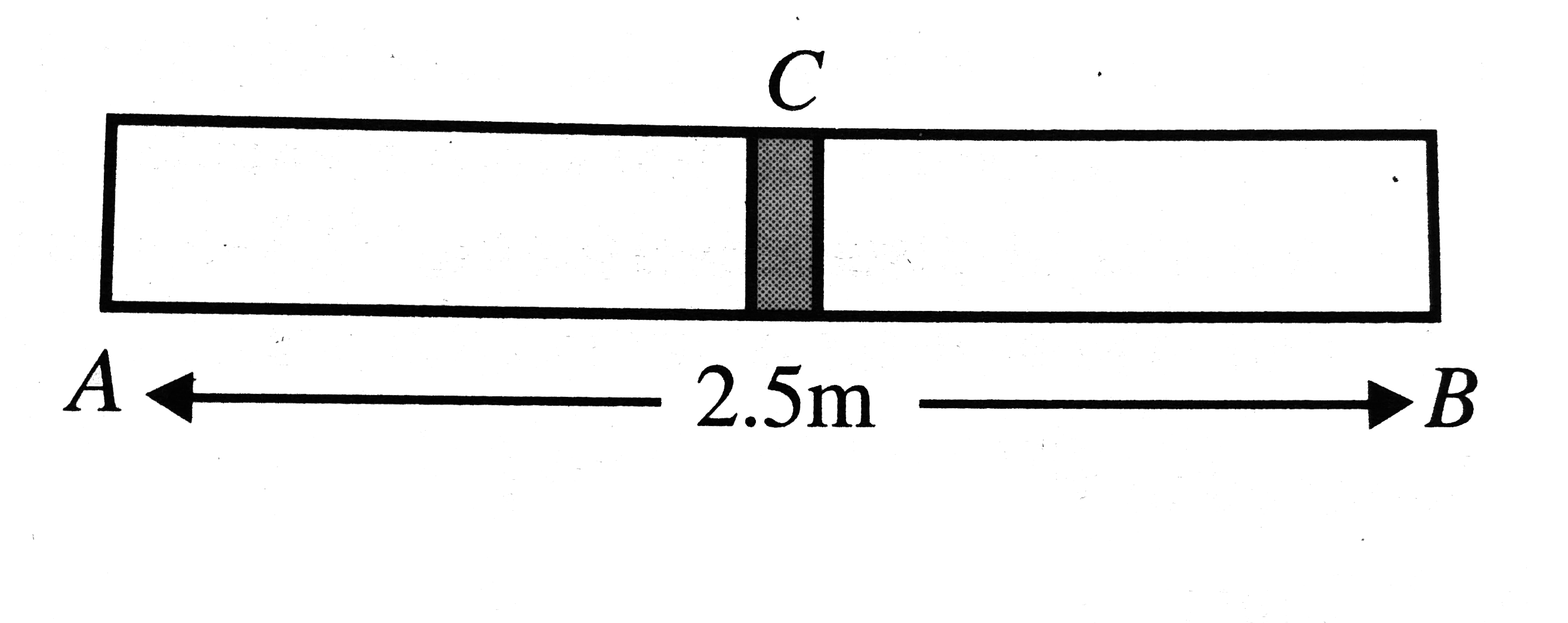A steel rod is rigidly clamped at its two ends. The rod is under zero tension at 20∘C. If the temperature rises to 100∘C, what force will the rod exert on one of the clapms? Area of cross section of the rod =2.00mm2 . Coefficient of linear expansion of steel =12.0×10−6C−1 and Young's modulus of steel 2.00×1011Nm−2.Solution in Tamil
θ1=20∘C , theta_2= 100^@C<br>A= 2 mm^2 = (2 xx (10^-6) (m^2))<br> (alpha_steel) = (12 xx 10^-6 /(^@C)<br>Y_steel = (2 xx (10^11N))/(m^2)<br>Forceexertedonthclamps=?<br>(F/A) / strain = Y <br> F= (Y xx (Delta L))/ L xx A <br> = (YL alpha Delta theta A) / L = ( YA alpha Delta theta)<br> =2 xx 10^11 xx 2 xx 10^-6 xx 12<br> xx 10^-6 xx 80<br> = 48 xx 80 xx 10^-1 = 384N
Topper's Solved these Questions
Similar Questions
A spinning wheel is brought in contact with an identical wheel spinning identical speed. The wheels slow down under the action of friction. Which of the following energies of the frist wheel decrease.
View SolutionTwo spherical balls of mass 10 hg are placed 10 cm apart. Find gravitational force of attraction between them
View SolutionA uniform slab of dimension 10cm×10cm×1cm is kept between two heat reservoir at temperatures 10∘C and 90∘C. The larger surface areas touch the reservoirs. The thermal conductivity of the material is 0.80Wm−1C−1 . Find the amount of heat flowing through the slab per minute.
View SolutionA steel rod of length 1 m is heated from 25^@ "to" 75^@ C keeping its length constant. The longitudinal strain developed in the rod is ( Given, coefficient of linear expansion of steel = 12 xx 10^-6//^@ C ).
View SolutionA steel rod 2.5m long is rigidly clamped at its centre C and longitudinal waves are set up on both sides of C by rubbing along the rod . Young's modulus for steel =2×1011N/m2 , density of steel =8000kg/m3

If the clamp of the rod be shifted to its end A and totally four antinodes are observed in the rod when longitudinal waves are set up in it , the frequency of vibration of the rod in this mode is
View SolutionA steel rod of length 5m is fixed between two support. The coefficient of linear expansion of steel is 12.5×10−6/∘C. Calculate the stress (in 108N/m2) in the rod for an increase in temperature of 40∘C. Young's modulus for steel is 2×1011Nm−2
View SolutionA brass of length 2 m and cross-sectional area 2.0 cm^(2) is attached end to end to a steel rod of length and cross-sectional area 1.0 cm^(2) . The compound rod is subjected to equal and oppsite pulls of magnitude 5 xx 10^(4) N at its ends. If the elongations of the two rods are equal, the length of the steel rod (L) is { Y_(Brass) = 1.0 xx 10^(11) N//m^(2) and Y_(steel) = 2.0 xx 10^(11) N//m^(2)
View SolutionFigure shows a steel rod of cross sectional ara 2 xx 10^(-6)m^(2) is fixed between two vertical walls. Initially at 20^(@)C there is no force between the ends of the rod and the walls. Find the force which the rod will exert on walls at 100^(@) C . Given that the coefficient of linear expansion of steel is 1.2 xx 10^(-5).^(@)C^(-1) and Young's modulus is 2xx10^(11)N//m^(2)
View SolutionTwo ends of a steel rod are rigidly fixed with two supports. At 30∘C its area of cross-section is 4 cm2. How much force will be exerted on the supports by the ends of the rod if the temperature of the rod is raised by 60∘C? [Young's modulus of steel =2.1×1012dyn⋅cm−2 and its coefficient of linear expansion is 12×10−6∘C−1]
View SolutionA Steel rod of length 25 cm has a cross - sectional area of 0.8cm2. The force required to stretch this rod by the same amount as the expansion produced by heating it through 10∘C is (coefficient of linear expansion of steel is 10−5/∘C and Young's modulus of steel is 2×1010N/m2).................... .
View SolutionThere is a change in length when a 33000 N tensile force is applied on a steel rod of area of cross - section 10^(-3) . The change of temperature required to produce the same elongation, if the steel rod is heated, is (modulus of elasticity of steel =3xx10^(11)N//m^(2) , coefficient of linear expansion of steel =1.1xx10^(-5)//^(@)C ........................
View SolutionA Steel rod of length 25 cm has a cross - sectional area of 0.8cm2. The force required to stretch this rod by the same amount as the expansion produced by heating it through 10∘C is (coefficient of linear expansion of steel is 10−5/∘C and Young's modulus of steel is 2×1010N/m2).................... .
View SolutionA steel rod of length L_0 . has a cross sectional area A. The force required to stretch this rod by the same amount as the expansion produced by heating it through DeltaT is (coefficient of linear expansion of steel is alpha and young's modulus for steel is Y ).
View SolutionA steel rod is clamped at its two ends and rests on a fixed horizontal base. The rod is unstrained at 20∘C. Find the longitudinal strain developed in the rod if the temperature rises to 50∘C. Coefficient of linear expansion of steel =1.2×10−5C−1.
View SolutionA steel rod of length 1m is heated from 25∘to75∘C keeping its length constant. The longitudinal strain developed in the rod is ( Given, coefficient of linear expansion of steel = 12×10−6/∘C).
View SolutionA brass of length 2 m and cross-sectional area 2.0 cm^(2) is attached end to end to a steel rod of length and cross-sectional area 1.0 cm^(2) . The compound rod is subjected to equal and oppsite pulls of magnitude 5 xx 10^(4) N at its ends. If the elongations of the two rods are equal, the length of the steel rod (L) is { Y_(Brass) = 1.0 xx 10^(11) N//m^(2) and Y_(steel) = 2.0 xx 10^(11) N//m^(2)
View Solution
